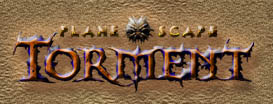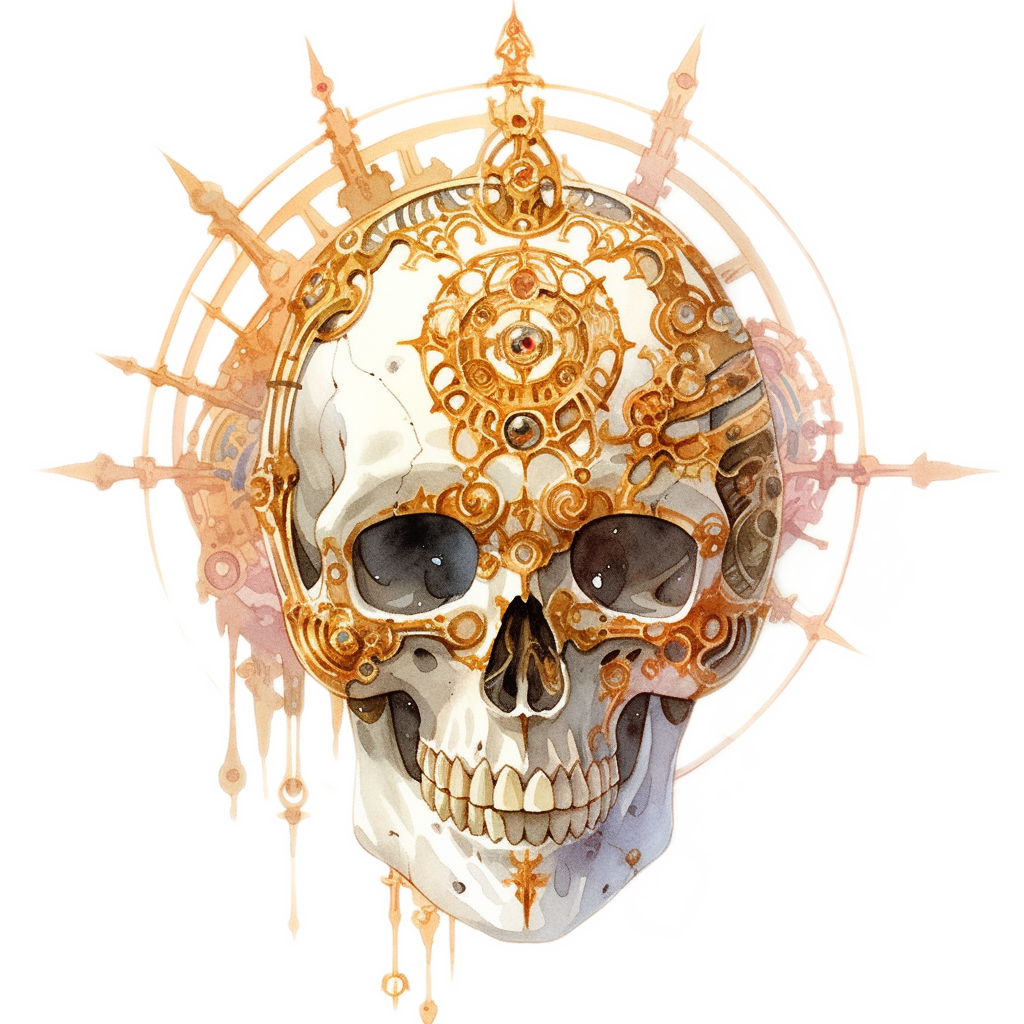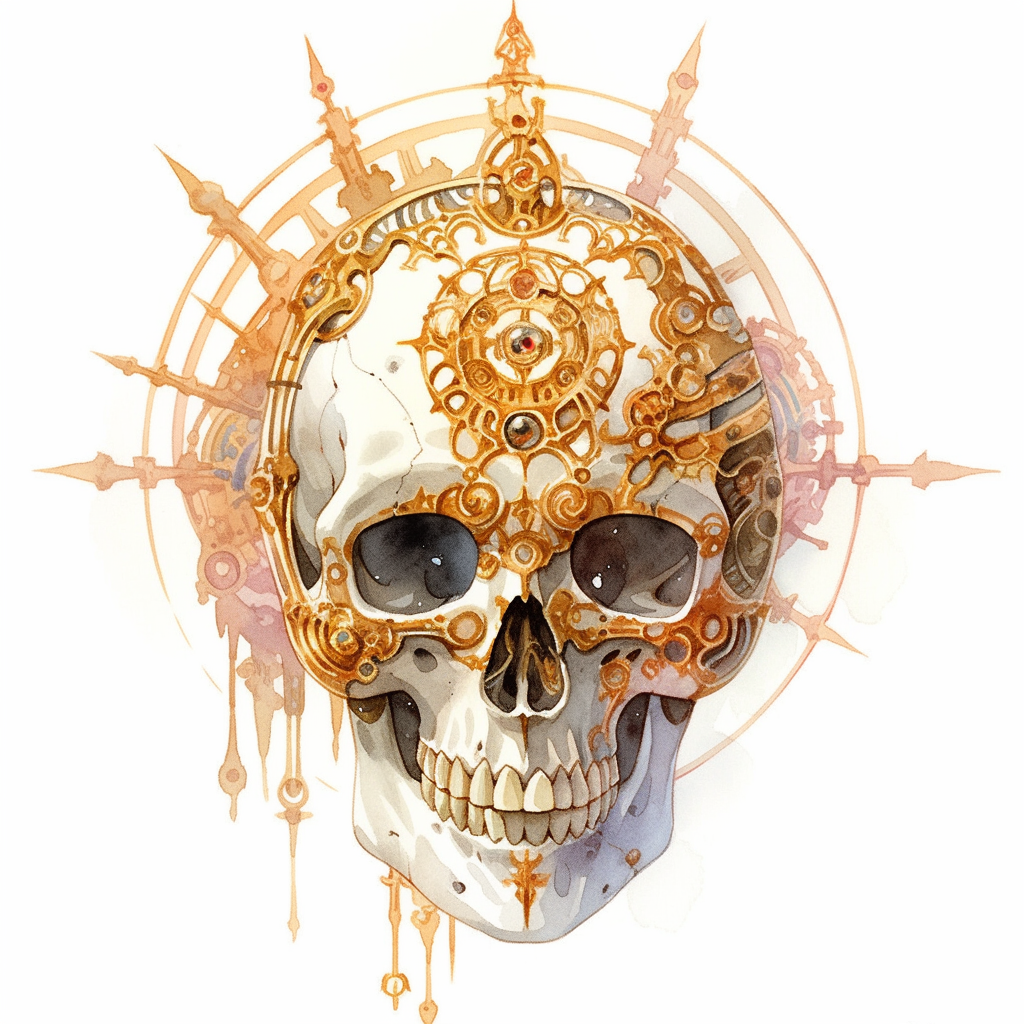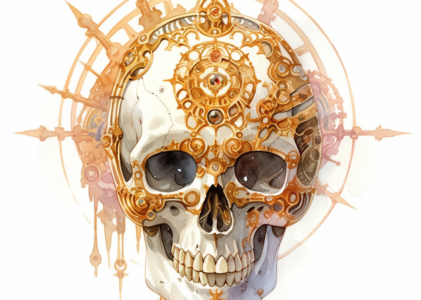An Interview with Ray and Val Vallese
Editor’s Note: Ray and Val Vallese, Planescape designers, where kind enough to indulge us for an email interview. Though they will not officially be attending Gen Con ’99, they have lanned us more chant then you can shake at with a dead cranium rat. Ray is, as many fans will recognize, the editor and designer of many Planescape fan-favorites such as UnCaged: Faces of Sigil, which he co-authored with his wife Val. (The books credit to R.V. Vallese sneakily incorporates both their names.) Val began work in TSRs books department after Ray’s employment at TSR, and is obviously one of the better creative minds that have helped bring Planescape’s memorable characters to life.
The interview is split into two parts: a general interview and a second, specifically focused on the upcoming novel, Torment.

PART 1
- Mimir.net: How long were you an employee with TSR, and how did you get into the gaming business?
Ray Vallese: I started work at TSR in June of 1994 and left in June of 1997 (just before WotC moved everybody out to the Seattle area). Since that time, I’ve continued to do freelance work for the Planescape line.
And as for how I got into the gaming business, well, I didn’t struggle for years and years to get my name known. I didn’t go to conventions and make contact with all the right bigwigs. I didn’t submit pieces to Dungeon or Dragon or do any of the things that all the fans are always told to do. Instead, I saw a want ad in the paper one day and sent in a resume.
That’s it. Now, on one hand that could make fans grind their teeth, but on the other, it should give them hope that sometimes it’s easier to break in to the industry than people think. (Of course, I had the right degrees, background, experience, etc.)
- How did you get involved with the Planescape product line?
Ray: Luck of the draw. As a new editor at TSR, I was assigned to the product group that worked on Planescape, since at the time it was a fledgling line.
My first project was “A Player’s Primer to the Outlands” (not exactly a fan-favorite, but Colin, Jeff and I did our best), and since I had no experience whatsoever with Planescape and very little with AD&D, I had to learn what I was doing very quickly indeed.
But I could tell right away that Planescape was where it’s at (or WAS at), and I knew with certainty that it was the game line I wanted to focus on. It was just so cool.
- Having freelancing for TSR for 2 years, what other projects have you been engaged in, either RPG or otherwise?
Ray: I edited The Product Formerly Known As “Servants of Light: The Celestials” (now retitled “Warriors of Heaven,” I believe), but the book has gone through substantial changes since it left my hands, so I can no longer say with certainty what it may or may not contain when it finally is published.
I co-edited “Inner Planes” with Michele Carter. I co-wrote “Faction War” with Monte Cook (and what a heap of controversy THAT book turned out to be!) Val and I co-authored the novelization of the Planescape: Torment computer game, due out in November (I think). And we also wrote a Rogues Galley of NPCs from the book, which will appear in Dragon magazine around the same time.
- What influences (music, philosophy, literature) do you recognize in your works?
Ray: I don’t listen to music when I write; I find it tends to interfere with the writing rather than guide it. And while I can’t point to a handful of specific books as major influences I’m a big fan of postmodern fiction, with all of its narrative trickery, unreliable speakers, and linguistic playfulness.
I think that’s why I like “Pages of Pain” so much. I love books that play with your head like “Pale Fire” (Vladimir Nabokov), “City of Glass” (Paul Auster), “Tristram Shandy” (Laurence Sterne, I think), “If On a Winter’s Night a Traveler” (Italo Calvino), and a bunch more that I can’t think of right now. And hey, in case anyone reading this thinks I’m a big lit snob guy or something, remember — I read lots of comic books, too. Too many, in fact.
- Do you role-play much in your spare time?
Ray: In my what? Sorry, I don’t understand those strange words you use.
When I worked at TSR, I did indeed role-play in my spare time, usually under the aegis of uber-DM Monte Cook (he’s great!). And since I had never really done it before coming to TSR, it was new and exciting and lots of fun. I especially liked Monte’s “Call of Cthulhu” campaigns (we did one that was set in the 1920s and one in the 1990s). But now that I’m no longer immersed in the role-playing culture, I don’t partake. And as I said earlier, I don’t have time these days, anyway.
- Are any of the characters from Uncaged: Faces of Sigil inspired by people you know? If so, which character(s), and how? (Thanks to Jon Winter for this one!)
Ray: My wife Val had as much to do with “Uncaged” as I did, so she’s got a few answers for you below mine. As for me, I can only think of Harys Hatchis. We took the basic idea for him from “In the Cage” but fleshed him out with the personality of Val’s wheeler-dealer uncle.
Other than that, I’d have to say that we just made everyone else up. A dull answer, I know, but thank goodness, eh? I’d hate to have someone like Shemeshka for a friend or relative. (Actually, did you ever notice the gender symbol in Shemeshka’s stats? An error introduced in typesetting, but a darned ironic one, given her nickname. Sure, Planescape’s alternative, but still . . .)
Val: Wooly Cupgrass — This is the name of a weed found in corn and soybean fields. My dad’s a farmer and ever since I was but a spit of a girl, I’d heard the term and found it particularly funny and wonderful, better suited to a character in a book than to a spindly weed. This was my chance!
Seamusxanthuszenus — I had a lot of fun picking out names for characters. I’d pore through a great baby names book, compile a list of finalists, and then Ray and I would choose a winner. For the mephit, I loved three similar names: Seamus, Xanthus, and Zenus. As I read them out loud, the list of three sounded so musical that we said them again and again and they blended into one.
the Grixitt — The first-person voice for this character came from the desperate, obsessive voice that would edge into my head when I couldn’t sleep at night. Before I started in TSR’s book department, I was becoming even more of a night owl than I already naturally was, staying up later and later and feeling more isolated from others as I did things while (seemingly) everyone else in the workaday world was asleep.
Morvun and Phineas — I loved these guys; they’re an amalgamation of my guy friends from high school who were members of struggling garage bands, all pale, angst-ridden poets who were so serious and so funny at the same time. Writing those “Death” poems for Morvun was TOO much fun.
Editor’s note: We will hear more from Val in Part II of this interview.
- Which is more hip: goatees or side-burns?
Ray: I think both are well past their glory days, such as they were. It’s time for the rebellious youth of today to invent a new badge of hep-cat coolness — something appropriate for the millennium, I think. Maybe the Mimir can sponsor a contest.
- Your works have inspired may others to produce their own creations. Many of these inspirations make their way to the net as fan-sites, such as the Mimir.net. Do you ever frequent such sites? What is your impression of them?
Ray: It’s always fun to check out a good Planescape site, although I don’t visit any with any regularity. Most of them are filled with great ideas, and I never want to read and absorb something and then subconsciously use it later in my own work. It’s better not to read all the fan-created stuff. I do, however, read reviews of PS products, try to answer questions — things like that.
- But Mimir.net really is the best though, right?
Ray: Well, sure! (I just wish Jon wouldn’t hyphenate those words next to the mimirs on his opening page. “Chat-tering” isn’t so bad, but “Expl-orer” just bugs me . . .) Actually, the Mimir is a truly excellent site, and I would say that even if it WEREN’T sponsoring this interview.
Editors note: Absolutely no money was exchanged in return for the rights to conduct this interview. And if there was, we would vehemently deny it.
- When was your first Gen Con? What was it like?
Ray: My first GenCon was August of 94, just a few months after starting at TSR. I felt like I had been abducted by aliens and thrust into an oddly fascinating biological preserve. It was an unexpectedly large amount of work and an equally unexpectedly large amount of great fun, and it helped me forge fast friendships with my new TSR comrades (there’s nothing like bonding through crises). Was that the year that James “Scotty” Doohan was a guest? (You have to refer to him like that, by the way — it’s the law.) We had a great idea for a publicity stunt involving ol’ Scotty, but I can’t talk about it here.
- What do you like to do at Gen Con?
Ray: Most of my TSR friends ached to have free time at GenCon so they could walk around and soak up all the new games and dice and whatnot.
But since I wasn’t steeped in that culture, I found that I enjoyed working the show: running game demos, attending seminars, paying $49.99 for a hot dog — well, not that last part.
And when I wasn’t on call, I liked to comb through back-issue bins of comic book dealers, check out old movie posters, and search for 50s sci-fi/monster videos (especially Godzilla, and I’m not talkin’ this newfangled CGI crap, sonny, I mean the REAL Godzilla, the guy in the rubber suit, by gum! I recently heard that Toho is going to bring back classic G for a new movie in 2000 — hurrah!)
- What are you looking forward toward this year?
Ray: Mainly, hanging out with friends that I don’t get to see as often as I’d like. Now that I no longer work for TSR, I get to be the bad influence, encouraging my pals to ditch their assignments so we can hang out instead.
- Any tips for first time Gen Con attendees?
Ray: Find Keith Strohm, who’ll probably be spending a lot of time wandering around the TSR area, and tell him “Ray says WOW!” Make sure to really stress that last word — make it not so much a shout as a growl. Let’s see how many wows he gets by the end of the show.

PART II: Torment, the novel
- Mimir.net: How were you contacted to do this novel? Was the choice to pursue this particular revenue stream driven by TSR or Interplay? How did you both get involved?
Ray Vallese: A friend of ours in the TSR Book Department called us up out of the blue one day and asked us if we’d like to submit a proposal for the novel. He mentioned that a few other people were in the running and thought that we’d be a good choice, too.
The offer was made to either or both of us, so naturally we decided to do it together. We put together our proposal and writing sample, then sat back and bit our nails until we got word that it was a go.
- How did you prepare for this novel? (What inspirations/sources?)
Ray: One criticism we’ve heard of the other Planescape novels is that they weren’t always true to the game setting, that the authors took too many liberties. Now, we personally don’t agree with those criticisms — we don’t feel that books should adhere to every game rule and stat — but we decided that we’d try our darndest not to break any PS rules with Torment.
We already had a lot going for us in that respect, since we already knew tons about the setting. But we still had stacks and stacks of PS source books by our side at all times, checking and cross-checking facts and maps and names and whatnot. We specifically did NOT re-read any of the existing PS novels, just to make sure that we wouldn’t accidentally borrow something from them.
- Along these lines, as authors writing in an established setting, and indeed a pre-established plot, how did you deal with the established limits of your artistic freedoms?
Ray: This part was perhaps the most difficult. Writing in the established PS setting was no problem; as I mentioned above, we were having a blast poring through all the source books and making things jive. But following the pre-established plot was a bit harder; at times we did feel that we needed to take the writing in places we might not have gone otherwise.
We were sent a several-hundred-page document that outlined pretty much every step of the computer game, and while we weren’t expected to adhere to it 100%, we were expected to stick to the main plot and characters, without introducing any new people or locations or elements. Throw in the fact that this book will be 70-80 pages shorter than a typical TSR novel, and that means that we had to mercilessly trim away the fat and focus only on the meat. (For instance, Xanxost the slaad was in our first draft, but he didn’t make the final cut. Sob!)
Certainly, it was frustrating at first. But the book shaped up to be a roller-coaster ride of excitement and action, very true to the computer game and the PS setting both. We hope that fans of each will be pleased.
Val: Once our main character began his journey and we had a clear conception of his characterization, it was sometimes hard to steer him through the established plot of the game, no matter how INTERESTING the next step was.
That was due to two reasons. First, there’s so much that can happen in Planescape that we kept thinking of new possibilities. Second, once we had an idea of how he wuld think and act — an idea of his character — there were times that we had to write or rewrite explanations for it to make sense that he would choose the next step that he did. This didn’t reflect the game material, only the situation of developing more three-dimensional characters with motivations, pasts, etc. out of a pre-established plot.
- In what ways did you make the work your own?
Ray: On the most basic level, we got to choose the style of narration, tone of the writing, pacing, and all that good stuff. The main character has a few interesting flaws (other than being an amnesiac — the guy’s just down on his luck all around, poor sod), and since everything is filtered through his eyes and senses, it required us to adopt a certain style of writing.
For example, if the main character is the kind of guy who would happen to describe an astonishing event in a flat, even manner, that’s how the writing describes it. If the main character is looking in one direction and doesn’t notice something important happening behind him, the reader isn’t privy to that information either and will be just as surprised by it.
Beyond that, we got to have fun fleshing out all the main characters and inventing whatever secondary characters we wanted to include. We also put a big twist in the ending of the book, so that people who play the game would be surprised by the novel (and vice versa). (Of course, since the fine folks at Interplay have already read our book, it’s possible that they will incorporate elements from the book into the game, so that the two products match even more closely.) We also tried to poke a bit of good-natured fun at cliches that always seem to crop up in these kinds of novels.
Val: Yes, we tried to have fun with it, especially with the character of Morte, a floating skull. There were numerous underground locations in the game that we had to use in the novel, so we had Morte complain (as regular people might) that he was getting mighty sick of spending so much time below ground (which in itself is odd, coming from a skull). When things slowed down a bit between scenes of big action, Morte whined that he was getting bored. As the heroes journeyed from place to place in search of information and kept being told to go find so-and-so instead, Morte groused about how they were on a wild goose chase across the multiverse. And so on.
- Ray, how did writing this book differ from others, such as PS supplements, you’ve written?
Well, we had to write it on an extremely tight deadline. For the first draft, we had about as much time as a TSR designer would normally have for a 64-page adventure or accessory (and we had no artwork, maps, etc. that counted toward our page count!).
So it was a lot more pressure. Plus, I always tended to write PS supplements in chunks, jumping around in the text and working on whatever I felt like at the moment. But since things were constantly changing in the novel, we had to start from page 1 and go straight through to the end (it would have done us no good to write the whiz-bang climax first if it would only end up changing later).
Finally, RPG supplements are supposed to focus more on communicating the basic info and less on dazzling the audience with clever prose. (Granted, that’s not entirely true for the PS line, as many people have remarked that they’ve purchased PS products just to read them.) On the other hand, the way you write a book is just as important as what you’re writing about.
- Did you have any personal goals that you were trying to accomplish with this book?
Ray: It’s the first novel for either of us, so we’re very happy to have had the chance to work on it together.
Val: My head has always been full of lots of images and colors and words, and fantasy is a wonderful forum for letting those things out. Planescape is especially open to possibilities, and even though some appropriately bizarre scenes and characters had to be cut (due to length, the editor’s preferences, etc.), I’m thankful that our first novel was so kind to our imaginations. Yay weirdos!
- What do you feel is the relationship between RPG, novels, and computer games?
Ray: I always used to think novelizations of movies were odd, simply because the best films usually take into account the visual nature of their medium and offer an experience that can’t necessarily be captured in words. Try turning a David Lynch, Peter Greenaway, Terry Gilliam or Coen brothers film into a novel. (I suppose you could argue that the “best” films aren’t the ones that are usually turned into novels.)
It’s just as hard with RPGs and computer games, I think, but in a different way. So much of the enjoyment comes from the player’s imagination and freedom to choose his own path that it seems like it’d be hard to capture that in print.
Clearly, when writing Torment we had to make choices as to what the main character would say, think, and do. We had a plot outline — “Joe has to go to the Great Laundromat of Sigil and wash his undies” — but we had to build everything else. Thus, someone who only plays the computer game will no doubt have a vastly different experience of what Torment is all about than will someone who only reads the novel.
The computer-game player completely controls the main character. The reader does not.
- Recently the producers of the popular Diablo computer game released news of a Diablo AD&D supplement in the works. This is clearly a reversal of the typical flow of revenue streams solely from RPG to computer games. Do you think Planescape pen & paper may see a surge in interest from this same direction with the release of the Torment computer game? What part do you believe the novel will play in this arena?
Ray: I sure hope that happy Torment fans decide to give Planescape RPGs a try; I know that the designers have tried very hard to make the game true to the PS experience.
The computer game features characters, monsters, and locations directly from the RPGs, after all. I think it’s probably more likely that people will play the computer game and then seek out the novel, rather than the reverse, simply because the computer game is being marketed in a big way. On the other hand, there haven’t been many novels for the PS setting, so fans of the RPGs may pick up the book and then move on to the computer game. It’s hard to say. Let’s all just hope that everything sells well and earns everyone scads of money and makes everyone happy.
- And finally, the big question, Jar Jar Binks: Lovable -but hairless- Wookie stand-in, or waste of gigabytes?
Ray: I didn’t hate him as much as I expected to, given all the slams I’d heard leading up to my viewing of the movie. Maybe that was Lucasfilm’s plan all along—leak word that Jar Jar is a film-sinking abomination, thus lowering everyone’s expectations to rock bottom, which then doesn’t make the goofy gungan seem so bad when you actually see him on the big screen.
Oh, all right: Waste of gigabytes. And isn’t it strange what movies have come to these days, with so much CGI? Movies aren’t movies any more; they’re digital collages that can be tinkered with too much, I think. Pretty soon a director won’t need locations or props or even actors; he’ll just sit in front of his PC and do everything digitally. It doesn’t bother me with music — I think it’s great that a guy like Fatboy Slim can turn on his PC and build a whole album out of samples and layers — but for some reason, it really bothers me with movies.
I guess I’m weird.
Source: Nathan Letsinger, additional questions by Ken Lipka


